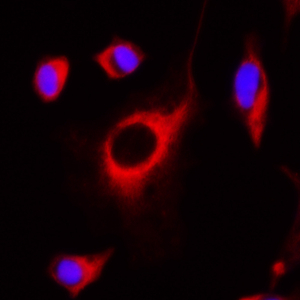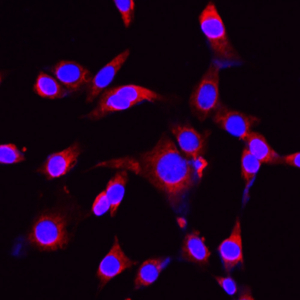Anti-UQCRQ Rabbit pAb (100 μl)
| Reactivity: | H,M,R & H,M |
| Applications: | WB & ICC/IF |
| Host Species: | Rabbit |
| Clonality: | Polyclonal |
| Gene Name: | Cytochrome b-c1 complex subunit 8 |
Synonyms: | Complex III subunit 8, Complex III subunit VIII, QCR8, QP C, QPC |
Immunogen: | KLH conjugated Synthetic peptide corresponding to Mouse UQCRQ |
Uniprot ID: | Q9CQ69 |
Isotype: | IgG |
Purity: | Affinity purification |
Predicted MW. / Observed MW. | 10 kDa / 13 kDa |
Subcellular location: | Mitochondrion |
Product Usage Information
WB | Human, Mouse, Rat | 1: 1500-1: 2000 | liver, skeletal muscle, placenta |
ICC/IF | Human, Mouse | 1: 100-1: 600 | NIH-3T3, HeLa |
Background
Component of the ubiquinol-cytochrome c oxidoreductase, a multisubunit transmembrane complex that is part of the mitochondrial electron transport chain which drives oxidative phosphorylation. The respiratory chain contains 3 multisubunit complexes succinate dehydrogenase (complex II, CII), ubiquinol-cytochrome c oxidoreductase (cytochrome b-c1 complex, complex III, CIII) and cytochrome c oxidase (complex IV, CIV), that cooperate to transfer electrons derived from NADH and succinate to molecular oxygen, creating an electrochemical gradient over the inner membrane that drives transmembrane transport and the ATP synthase. The cytochrome b-c1 complex catalyzes electron transfer from ubiquinol to cytochrome c, linking this redox reaction to translocation of protons across the mitochondrial inner membrane, with protons being carried across the membrane as hydrogens on the quinol.
Images
| Western blot analysis of UQCRQ (GB115003) at dilution of 1: 2000 |
| Immunocytochemistry analysis of 4% paraformaldehyde-fixed HeLa cells using UQCRQ (GB115003) at dilution of 1: 400 |
| Immunocytochemistry analysis of 4% paraformaldehyde-fixed NIH-3T3 cells using UQCRQ (GB115003) at dilution of 1: 400 |
Storage
| Storage | Store at -20°C for one year. Avoid repeated freeze/thaw cycles. |
| Storage Buffer | PBS with 0.02%sodium azide,100 μg/ml BSA and 50% glycerol. |






